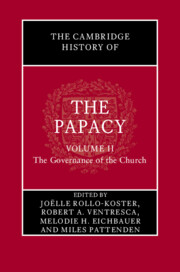Book contents
- The Cambridge History of the Papacy
- The Cambridge History of the Papacy
- Copyright page
- Contents
- Figures
- Tables
- Maps
- Contributors
- General Introduction
- Part I The Pope within the Church
- 1 Vicar of Christ, c.1050–c.1300
- 2 The Pope, the Archdeacon, and the Clergy: A Competition
- 3 From Papal Absolutism to Vatican II
- 4 Vatican II and Its Legacy
- 5 The Synod of Bishops since Vatican II
- Part II The Roman Curia
- Part III Canon Law
- Part IV Finance
- Part V Papal States
- Select Bibliography
- Index
2 - The Pope, the Archdeacon, and the Clergy: A Competition
from Part I - The Pope within the Church
Published online by Cambridge University Press: 28 February 2025
- The Cambridge History of the Papacy
- The Cambridge History of the Papacy
- Copyright page
- Contents
- Figures
- Tables
- Maps
- Contributors
- General Introduction
- Part I The Pope within the Church
- 1 Vicar of Christ, c.1050–c.1300
- 2 The Pope, the Archdeacon, and the Clergy: A Competition
- 3 From Papal Absolutism to Vatican II
- 4 Vatican II and Its Legacy
- 5 The Synod of Bishops since Vatican II
- Part II The Roman Curia
- Part III Canon Law
- Part IV Finance
- Part V Papal States
- Select Bibliography
- Index
Summary
At an early time, the role of the laity in the Roman Church diminished as a body of clergy under the authority of a bishop became established as a separate caste. Its members resembled civil servants, as was implied by the word used for the procedure by which one joined them, “ordination,” that was familiar from Roman secular life. They manifested some of the characteristics of the members of a bureaucracy, in being prepared to pay for an office, a practice known as simony, and in being concerned for promotion. The clergy were divided into two streams with separate promotion structures, one of subdeacons, deacons, and archdeacons, and the other of acolytes, priests, and archpriests. Of these the former was more prestigious, and more likely to culminate in the office of pope, the bishop who exercised control over the other clergy. The body of clergy was by no means harmonious, and there were frequently tensions within it. While laypeople were excluded from the prominent position they had held when the church was established in Rome, the clergy continued to be connected from the families from which they came.
- Type
- Chapter
- Information
- The Cambridge History of the Papacy , pp. 62 - 81Publisher: Cambridge University PressPrint publication year: 2025

